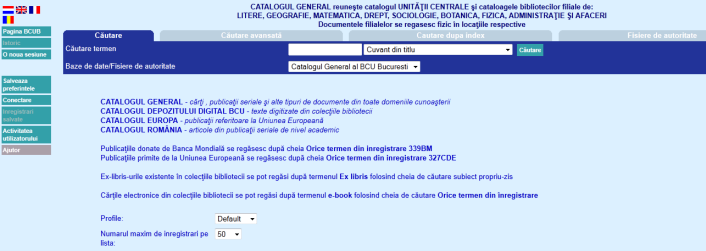Introduction
For a detailed history about the compiling of national bibliographies in Romania see Theodorescu B., Istoria bibliografiei romane, Bucuresti, Editura enciclopedica romana, 1972 and Cornelius Dima-Dragen, Das Rumänische Buch- und Bibliothekswesen, Wien, 1980.
The first Romanian printed bibliographies are to be found in the periodicals Curierul Romanesc (Bucharest, 1829), Albina Romaneasca (Jassy, 1829) and Gazeta Transilvaniei (Brasov, 1838). Bibliographical information was also present in calendars and almanacs, the most popular periodical of that time in Central Europe. These early periodicals were efforts of learned literary and cultural associations that began forming during those decades, including in Brasov (1821), Bucharest (1844), and Sibiu (1861). Yet it was not until 1866 when the evolution of such a learned society into a Western-style academy, marked by a gathering of national intellectual forces toward an understood notion progress through science and culture, took place. This academy, called initially the Romanian Academy Society, was created in Bucharest soon after the unification of Wallachia and Moldova in 1859 and became the Romanian Academy in 1879. Intellectual centralization made possible the first monthly bibliographical publication beginning in 1879 under the title Bibliografia romana: Buletin mensual al Librarie Romane generale din Romania si al librariei romane din streinatate (some issues held at the British Library and the French National Library). It came out until 1890, with some interruptions. An alternative title for that time was the journal Convorbiri literare. For the period 1866-1904, see also the yearly publication of the Romanian Academy Analele Academiei Romane (some issues at Berkeley). These early bibliographies cannot be considered national bibliographies, however, because they did not appear regularly and were not complete.
In March 1901 a law prescribed that all the books and manuscripts belonging to the Central Library of Bucharest should be given over to the Romanian Academy, which would incorporate them in its collection. With this, the Biblioteca Academiei Romane (Romanian Academy Library) officially became the National Library. This institution was meant to serve as the national depository for Romania. In 1903 the Academy bibliographer and university professor Ioan Bianu, together with bibliographer Nerva Hodos, began published the bi-monthly bibliographic journal Revista bibliografica, until 1905. New York Public Library is the only institution in US that holds it. That same year they released the first volume of the first Romanian national bibliographic publication, the Bibliografia Romaneasca Veche, a retrospective bibliography covering the years 1508-1716. Volumes II (1716-1808) and III (1808-1830) were released soon thereafter, in 1910 and 1912 (volume III would not be completed until 1930). These works set the tone for future national bibliographic efforts and cemented the place of Bianu as the historic dean of Romanian national bibliographers. The next major retrospective effort, the four-volume Bibliografia Romaneasca Moderna, was published much later, beginning in the early 1980s and not completed until after the collapse of communism. Nevertheless,it followed Bianu’s organizational example on many intellectual fronts.
Bianu’s retrospective work ended in 1830 not by accident. Most historians agree that around this time, Romanian publishing, including newspapers, academic journals, and monographs, entered an era known as the “period of transition,” which lasted at least to some extent for half a century, until about 1880. This long period was marked by the transition of the Romanian written language from the Cyrillic alphabet to the Latin. Cyrillic was borrowed in the 9th century from Bulgarian together with Christianity, when the Romanian Orthodox Church was organized. Eastern Orthodoxy was a logical choice given the Romanian conversion to Christianity from the Eastern, or Greek, Orthodox tradition and Romania’s proximity to Bulgaria, the first Balkan people to convert to Eastern Orthodoxy (the Romanian Church initially owed its allegiance to the Bulgarian Patriarch). However, beginning in the late eighteenth century in Transylvania and spreading throughout the principalities of Wallachia and Moldova by the early to mid nineteenth century, the Romanian nationalist movement was intricately linked to the understood blood connection of contemporary Romanians to the ancient Romans, whose language was Latin. While this theory of Latin descent had been heard among elites before, it was toward the end of the 1700s that particularly Greek Catholic (Uniate) clergy in Transylvania turned to the Latin descent idea in order to obtain equal rights denied Romanians in Transylvania in preference for the three “recognized” nations of Magyars, Saxons and Szeklers. In direct contradistinction to the Romanians’ label as “newcomers,” a new class of clerical intellectuals sought to show that the Romanians were in fact the oldest continually residing community in Transylvania by dint of their direct Roman connection. To this effect, Samuil Micu and Gheorghe Sincai published in 1780 in Vienna the first Romanian book in the Latin script, “Elements of the Daco-Roman or Wallachian Tongue.” Eventually, the Latin theory of descent became a source of collective pride among most Romanian-speaking elites, both secular and clerical, and furthermore served as a point of imagined difference between the Romanians and their surrounding Slavic, Hungarian and German neighbors. Yet the orthographic transition took a long time, as not everyone jumped on board with the idea. The official Romanian conversion to a Latin-based alphabet was completed only by 1862, soon after the unification of the principalities around Prince Cuza in 1859, although the Cyrillic script lingered in numerous publications until just after the international recognition of an independent Romanian state in 1878.
This period in Romanian publishing history, roughly from 1830 into at least the 1860s but to some extent until the 1880s, presents a challenging issue for bibliographers and researchers alike. Romanian Cyrillic orthography was largely unreformed from medieval days (unlike the Russian alphabet for example), such that materials from before 1830 contain many letters from Old Church Slavonic that are difficult for the modern non-specialist to decipher. What is more, the orthographic transition was not centrally organized but took place quite haphazardly. Some more nationalist-inclined publications switched earlier, others much later. Some “more extreme latinizers” desired an alphabet designed more to suit ideological perspectives than satisfy phonetic reality. In certain cases, readers were surprised to discover that newspapers switched script in the middle of a publication without any indication or recognition within the text that it was happening.
It was in part to avoid this legacy of orthographic confusion that when bibliographic entries where compiled into catalogs beginning in the 1880s that Romanian libraries and archives used Latin transliterations in their catalog entries for older materials rather than presenting them in the original Cyrillic. A uniform, consistent transliteration system, however, was not in use during the late 19th and early 20th centuries when the catalogs for the older materials in the national and university libraries were created, thus leading to search difficulties. Researchers must be aware of this changeover because it can lead to problems when searching for older materials, particularly when searching for materials on-line via the rapidly growing digital collections at the Romanian libraries. Scholars must be aware that older materials will sometimes require various and numerous attempts at spelling, and of course the more information is known about a particular document, the higher the likelihood that it can be located. Even when researching on site at the national or academy libraries and/or archival catalogs, researchers must keep in mind the fact that quite often catalog entries may not follow transliteration rules accurately. This applies not only to the historical orthographic transition, but also to linguistic differences: many different peoples using several different languages lived (and live) on the territory of contemporary Romania and their sources were not always entered into Romanian-language catalogs consistently.
The first half of the 20th century was a volatile time for Romanian publishing. After the first World War valuable bibliographies were published as a supplements to periodicals, first in Buletinul cartii (1924-1926) and then in the newspaper Universul literar (from 1926). The lack of a real systematic national bibliography was overcome through bulletins published by some editors, particularly by the publishing house Cartea romaneasca. For the time after WWII the work which is more similar to a national bibliography is the Romanian bibliography compiled by D. Panaitescu-Perpessicius and published in the journal Orizont (1945-1947). A formal national bibliography did not begin being issued in print form until 1952. The role of the national repository reverted to the National Library in 1955 after a 54 year suspension, under the name Central State Library. It was formally recognized under the current title of “National Library of Romania” only in 1990, after the bloody collapse of the repressive communist regime of Nicolae Ceaușescu. Romanian publishing came in line with European standards in the 1990s largely through the initiative of the European Union. For example, the Cataloging-in-Publication process was assigned to the ISBN Agency in 1997, which launched the process in Romania, at the behest of the European Commission’s Education for Change project. The revising of the Legal Deposit Law in 1996 was also important to streamlining the bibliographic process. The number of legal copies required for every publication was revised from nine to seven, although during much of the Communist era the requirement was as high as 22 (!), which promoted violation of the law by many publishers. In addition, during the 1990s the automation of the bibliographic catalog, which began in 1983 on “home-grown” software, was converted to a universal format and prepared for expansion. This streamlining of the bibliographic cataloging process has opened the door to the rapid modernization of Romanian holdings and on-line access to them in the first decade of the 21st century.
National Bibliographies
Cresterea colectiunilor
Bucuresti: Biblioteca Academiei Romane, 1907-1919.
U of I Library Call Number: International & Area Studies Romanian/Moldovan Reference (Slavic) A.858Ac1c (1905-1919).
The earlier years of this publication are easier to find, but no institutions in the U.S. holds the volumes from 1920 to 1942. Scholars interested in them should refer to Germany’s Bayerische Staatsbibliothek. Post-WWII holdings are better. The National and University Library of Strasbourg, for example, has holdings from 1964-1975 http://www.bnu.fr/. These volumes are additionally challenging to search because the name changed between “Crestera” (increase or growth) and Cresterile (increases or growths). The gap from 1919 to 1952 will probably soon be covered, since the Romanian Academy Library is now working on a project called Bibliografia romanesti contemporane (1919-1952). For more details see http://www.bar.acad.ro.
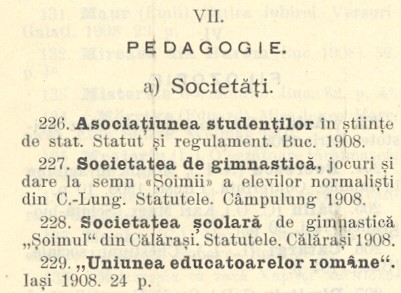
First published under the title Cresterile Colectiunilor, this quarterly bulletin is considered the first attempt to a national bibliography, because the entries are based on items which were made obligatory to give to the Romanian Academy Library. This publication is essentially the printed catalog of holdings of the Romanian Academy of Sciences for the years 1905-1944. As the name implies, the desire of the compilers was to create a large body of organized literary and scientific items worthy of broader Romanian efforts to join the family of “civilized” western nations. This was thus among the first state efforts (together with Bibliografia Romaneasca Veche described below) to collect as widely across the recently unified principalities as possible and to establish a single repository. It is important to note that the greatest benefit to this collection in simply informing scholars about the vast array of primary documents available in the Academy Library. For the contemporary researcher, most of the materials listed will be inaccessible except by traveling to the Romanian Academy Library.
Every bulletin begins with a report about the developments in the collection. The bibliography that follows is organized by subjects: 1) Bibliographies and Encyclopedia; 2) Publications by Academies of Science; 3) Philology; 4) Literature; 5) Arts; 6) Philosophy and Sociology; 7) Education; 8) Theology; 9) History and Auxiliary Sciences; 10) Geography and Ethnography; 11) Political and National Economics; 12) Industry and Commerce; 12) Communication, Telegraph, and Post; 13) Finance; 14) Statistics; 15) Decrees and Laws; 16) Politics; 17) Administration; 18) Mathematics and Astronomy; 19) Natural sciences; 20) Physics and Chemistry; 21) Medicine, Hygiene and Veterinary; 22) Army; 23) Society; 24) Miscellaneous. Within each subject there is another division: first the serials are listed by journal name and then the monographs listed by author. Other sections are devoted to periodical publications of general character, political organs, leaflets, stamps and photographs, manuscripts. Of particular interest is the section “Documents,” which contains a list of old Romanian documents held at the Library of the Romanian Academy, some from the XVI century. The last part of this quarterly publication is a description of the manuscripts and various documents conserved in special collections: the 1905 volume lists the contents of the Sturza family archive, the 1907 volume lists the collection of Nicolae Grecianu from Buzau, who collected documents and letters from boier estates while working as a servant. Such leaflet lists (Foi Volante) appear throughout the volumes of this collection. For example, a particularly long list at the end of the documents section of the October-December 1911 entry is devoted to leaflets appearing between 1642 and 1866. The list is geographically divided: Romania, Moldova, united principalities; Romanian leaflets in Hungary,Transylvania, Bucovina, Bessarabia, and abroad; leaflets in German in Hungarian in Austria and Hungary; leaflets in Russian, Turkish and in the Greek Patriarchate in Greek, etc. This list is indexed, but as with most other items of these collections, it can only be accessed at the Academy Library.
The first 5 numbers of this bibliographical work (1905-1907, Slavic reference has 1905 and 1907, not 1906) have no index. They can be searched only by subject. Within every section the citations are in alphabetical order; in most cases the works are cited under the author, but sometimes under the title. In the section “Academice” works are listed in the alphabetical order of the towns were the Academy is situated.
For the years 1908-1915 the last issue of the year is provided with an author index, which however is limited to the 24 subject sections. The section containing information on stamps, manuscripts, and documents are still not indexed. The years 1916-1919 are indexed together.
Bibliografia Nationala Romana ; previously Bibliografia Republicii Populare Romаne , Bibliografia Republicii Socialiste Romania, and Bibliografia Romaniei.
Bucharest: Biblioteca Nationala a Romaniei [previously Biblioteca Centrala de Stat a Republici Socialiste Romania], 1956-1998. This is the national bibliographic publication of Romania beginning soon after WWII. Given the turbulent political history of Romania in the post-war years, this publication has gone through several name changes, outlined here together with the holdings of the U of I library:
Changes in title and holdings:
1956-1966: Bibliografia Republicii Populare Romаne
1967-1989: Bibliografia Republicii Socialiste Romania
U of I Library has them all, beginning with July-Dec 1956. Call number: Main Stacks 015.498 B85B. (Missing v.35 1986)
Beginning with the January 1 issue of 2009, the entire publication is available online at the BNR website, archive page, at http://www.bibnat.ro/Arhiva-s237-ro.htm .
1990-1992: Bibliografia Romaniei (voll. 39-40)
U of I Library has only vol. 39. Call number: Main Stacks 015.498 B85B1.
LC: vol. 40, 21 (1-15 Noem. 1991) – vol. 41, 24 (16-31 Dec. 1992). LC does not have the first 6 months for 1991.
1993- 2002: Bibliografia nationala romana (voll. 42- 51)
U of I Library: 1997-1998 not complete. Call number: Romanian Reference 015.498 B85B1A .
Library of Congress: 1993-1994 complete; 1995-2002 not complete
Bochum University (Germany): 1993-2001 complete

Note muzicale. Discuri. Casete
Bucharest: Biblioteca Națională a României, 1991-2006.
U of I Library Call number: Main Stacks 015.498 B8521
U of I Library has: 1992-2006
This is the third series from the Romanian National Library’s (previously Central State Library of Socialist Romania) national bibliographic publication, after Series A on books and Series B on periodicals. It started in 1968, with a three monthly frequency. For the period before 1968, information about the Romanian musical production is to be found in the series A for books. This bibliography includes the national production of scores, CD, discs, and cassettes. It is divided into 2 big sections: CD and cassettes. Each section includes subsections devoted to literature and to music. There are two indexes: author and title index. The U of I Library does not have issues from the Socialist era, but has nearly a full run of the first 15 years of post-Ceausescu Romania.
Catalogul Publicatiunilor Academiei Romane, 1867-1937
Bucharest: Academia Româna, 1937. Not at U of I Library.
OCLC: 12126454 (Available at University of California, Los Angeles, American Museum of Natural History, and University of Oxford)
This bibliography was published in Bucharest by the Romanian Academy Library until 1937, the last year of nominal democratic government in the country before the return of effective dictatorship in 1938. This book is a bibliographic compilation of the annual conferences of the Romanian Academy members from 1867 until 1937. It is divided into two fundamental, organizational sections: the first chronological, detailing in several sections the topics discussed at the annual conferences year by year, and the second alphabetical. The first is useful for tracking the topics discussed at the sessions of the Romanian Academy annual conferences, including a separate section for literary and another for historical meetings (dominated for most of these years by Nicolae Iorga). Additional sections of history and science are given in French, an indication of the importance of this language in interwar Romanian academic pursuits. This is followed by a lengthy list of publications and presentations by academy members listed by name, and completed by a final section on progress on the special joint project on the history of the Romanians. Following this begins the alphabetical list of academy members and contributors by last name.
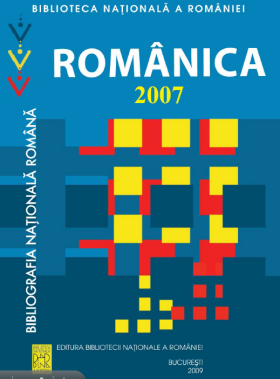 Bibliografia Nationala”Românica”
Bibliografia Nationala”Românica”
Bucuresti : Biblioteca Nationala, 2005-. Not at U of I Library.
OCLC: 71001515 (Available at University of Chicago, University of California, Berkeley, and Harvard University)
This bibliographic collection includes books and dissertations published outside of Romania but written or edited by Romanian, or partly Romanian, authors. It also includes volumes written by foreigners on topics dealing with Romania, the latter based on bibliographic information at the Romanian National Library (BNR). The guide is typically two years behind, i.e. the 2007 guide was published in 2009. U of I does not subscribe to this publication but it is available online through the BNR archive website, at http://www.bibnat.ro/Arhiva-s237-ro.htm. The indexing section at the back of each volume takes significant space, in part because the index is comprised of publication of many different languages. The section starts with a name index, followed by an index of titles and finally subjects.
Teze de doctorat
Bucharest: Biblioteca centrală din București, 1970-.
U of I Library Call number: International & Area Studies Romanian/Moldovan Reference (Slavic) 013 T318
This is a very briefly annotated bibliography of doctoral dissertations completed in Romania. It was first published by the Central Library of Bucharest University in 1948. UIUC has the full run (six volumes), covering the period from 1948 until 1991. Since 2009, this bibliography is accessible online through the archive website of the Romanian National Library ( http://www.bibnat.ro/Arhiva-s237-ro.htm ), although 2011 has not yet been published online. During the socialist era, the bibliography was published triennially (every three years). After an interruption following 1991, the publication started again in 1995, although it was published twice a year. During the early socialist years, the subject organization of the publication mimicked accepted Soviet guidelines (i.e. Marxism-Leninist first, followed by sciences, technical subjects, and finally humanities. In addition to a subject table of contents, each volume included a detailed author index at the end (1970, 1973, 1976, 1979, 1983, 1987, and 1991). By the early 1970s, the Soviet materialist science emphasis was dropped and subjects reflected less ideological organization, although the order remained the same. In addition to an author index, beginning with the 1973 volume the Bucharest University library also published an index of thesis advisers, an index of names contained in thesis titles, and an index of the academic institutions at which the dissertations were defended. Taken together, these indexes provide the possibility for incorporating Romanian doctoral dissertations into research projects of many disciplines.

Retrospective National Bibliographies
Bibliografia romaneasca veche 1508-1830
Ioan Bianu, Nevra Hodos, Bucharest: Editura Academiei Romane. Vol. 1: 1508-1716, published in 1903. Vol. 2: 1716-1808, published in 1910. Vol. 3: 1809-1830, in 8 fascicules published between 1912 and 1934. Vol. 4: Additions and corrections, published in 1944.
U of I Library Call Number: International & Area Studies Romanian/Moldovan Reference (Slavic) 015.498 B47b
It is chronologically organized. At the end of each volume there is a scheme, which summarizes the works included in the bibliography. The scheme is again in chronological order; it briefly repeats title, language in which the book was written, place of publication and number of pages. More helpful is the alphabetic index, including authors and titles.
The entries are very rich; apart from the bibliographical description, they include long citations and facsimiles reproducing the pages of the oldest Romanian books. Numerous liturgical engravings and artworks are reproduced in the pages of the first volume, arranged chronologically, each assigned a number. Many of the older works are ecclesiastical in nature, and one can readily see the connection between the early Cyrillic Romanian texts and Old Church Slavonic. The bibliographic entries describing these texts explore this connection often. Many of the texts are not in Romanian but in Old Church Slavonic, Russian, Serbian, Bulgarian, etc. Almost always they were published outside contemporary Romanian boundaries, in either Budapest, Vienna, Belgrade or Sofia. They are presented because they have been saved in the monastery libraries of either the principalities or Transylvania, which were not yet united at the time that Bianu and Hodos published this work. For the non-specialist in medieval history, the bibliography is itself a source, as it not only presents many of the foundational texts for Romanian publishing and linguistic development, but offer translations of old Romanian Cyrillic that few can read today.
At the end of each volume there are three lists of contents: the first arranged chronologically by year of each work. It also includes in each entry the name of the cataloged work, the language of the work, the place where the original is held, and the pages of the original text that are reproduced here in the bibliographic guide. The second is a descriptive list of artwork presented along with the entries throughout the bibliography, organized by number as given in the pages of the guide, including a one-line description and page number that they appear in the bibliography. Finally an alphabetical index by author or name of the entry.
In our collection the third volume is bound together with the second, and includes only the first two fascicules (1809-1817). Scholars must also be aware of the supplement Contributii la Bibliografia Romaneasca Veche, compiled by D. Poenaru in 1973 (Tirgoviste: Muzeul Judetean Dimbovita). The additions to these volumes published in 1944 are most easily accessible through the online version of the bibliography, available from the Academy Library at: http://www.biblacad.ro/bnr/brv.php .
Bibliografia Romaneasca moderna (1831-1918)
Bucuresti: Biblioteca Academiei Republicii Socialiste Romane, 1984-. 4 volumes.
U of I Library Call Number: International & Area Studies Romanian/Moldovan Reference (Slavic) 015.498 B4712 v.1-4 and Main Stacks v.1 and v.4
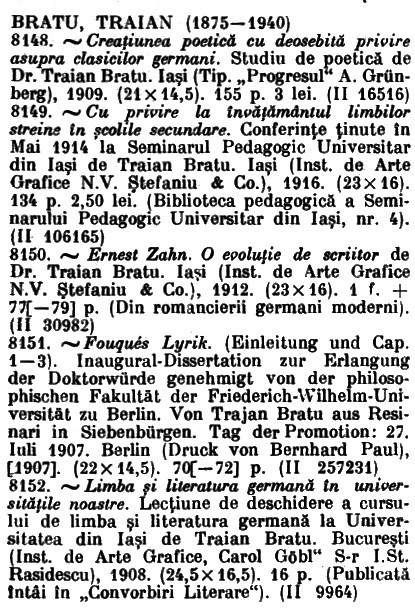
This work is a continuation of the Bibliografia romaneasca veche 1508-1830. The basis of the bibliography was the fund of the Library of the Academy, completed with investigations in other libraries in Bucharest and in the entire country, as well as titles of books mentioned in reference publications, but not located in libraries (in the bibliography these books are marked with an asterisk). The era covered by this bibliography is perhaps most challenging in Romanian history because of the change in orthography from Cyrillic to Latin at its beginning. While the overwhelming majority of Romanian printing on these pages was originally in Latin, some of it was in Cyrillic. These works are rendered (and alphabetized) in Latin transliteration, with an annotation typically included explaining that the original was in Cyrillic. This is helpful, but it stands to reason that there were discrepancies in the transliteration as the length of the orthographic transition ensured inconsistency. This is left for the researcher to discover.
The citations are presented in a unique alphabetical series for the authors and the anonymous works. The four volume set has one simple, alphabetical structure all the way through. In addition to authors names, there are also entries for associations and organizations, for literary and linguistic terms, etc. Most of the bibliographical descriptions include annotations concerning the contents, editions, titles, history of the book, existence in the book of indexes or bibliographical lists. There is no index. The current, four-volume work was designed to be only the first part of the project, with later volumes to include geographical, chronological, topical and name indexes. This never materialized, however.
Through an ongoing collaborative project between the Romanian Academy Library and the Informatics Research and Development National Institute ICI in Bucharest, the modern and old bibliographic collections are available and, more importantly, searchable online at http://www.biblacad.ro/bnr/index.html. The organization of the list is arguably more clear and user friendly than the printed version, although there are occasional problems, such as the inaccessibility of anything starting with the letters D, F, M, N, P and R-Z, for example. Nevertheless, the ability to search the database largely makes up for there not being an index, although subject searches are not possible, rather the system will find a name if spelled correctly.
Compiled during the height of, but not published until the end of Socialist Romania’s Ceausescu years, the modern bibliography’s preface serves as an important reminder of the unique mixture of socialism and nationalism that was communist Romania: “The spiritual life of a nation is mirrored in its writing and printing.” The project eclipsed the communist experiment, in fact, with the final volume not published until 1996. The reader is reminded that in Romania’s case, this national spirit consists of a mixed Roman and Byzantine legacy. The potential problem arises when considering who exactly fits into the definition of the nation: authors and works by Hungarians, Jews, Germans, etc are included in the bibliography but can hardly be considered part of the historic Latin-based legacy of the nation. The stated purpose of a national bibliography silences this fact: a national bibliography is not simply about organizing sources to make them accessible, rather it is partly about presenting an important part of a national organic whole. Typically, if the language of the text was other than Romanian we are informed, but if the person identified himself otherwise we do not know. The terms of belonging to the Romanian bibliographic nation is thus geographic: anything published on Romanian territory is considered Romanian.
On-line sources for the Romanian National Bibliography
Biblioteca Nationala a Romaniei
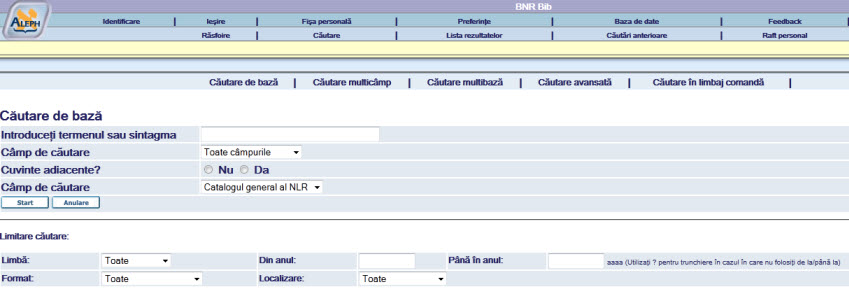
From the Web-site of the National Library of Romania (BNR, Biblioteca Naţională a României), it is possible to search their on-line catalog, http://aleph.bibnat.ro:8991/F . One can perform a simple or advanced search. There is also the possibility to list the publications by title, author, subject, etc.
This is also the OPAC for the Academy Library, described below. Currently, some 100,000 records, almost entirely from 1993 and newer, are accessible through the BNR OPAC. Digitization began in 1996, but picked up in pace from 1998. The retrospectivity of the catalog is by all accounts improving, especially for recent years. However, researchers have to keep in mind that there remains a long way to go in terms of coverage: for sources prior to 1993 held by the National Library, one will need to turn to the physical card catalog. There is so far no way to view the individual cards from the catalog online, and it would seem that this may be possible in the future either because it is unclear if the National Library is not scanning its catalog of holdings. The seasoned researcher knows that a digitized search alone will not find everything because of entry errors, transliteration discrepancies, orthographic changes, etc. A function of Romania’s turbulent, multi-ethnic and multi-linguistic history, the cataloging of records in the various languages that flourished on the territory of contemporary Romania has presented challenges for the national bibliographies. While essentially all card catalogs in Romanian libraries are in Latin script, their transliteration into that script (from Russian, Yiddish, Bulgarian, old Cyrillic Romanian, etc) was by no means uniform. These discrepancies in the traditional catalog is being passed onto the digital version. Researchers have to be aware of these problems and be prepared to search for many items many times in numerous, sometimes creative, ways.
In addition to the OPAC, numerous additional links provide access to ongoing library publications, although for the most part these are not retrospective. National Bibliographic publications are listed annually on the cite as well, although the collection is very limited, beginning only in 2009. For years before, one must look past the BNR. Likewise, new doctoral works are annually listed on the BNR site, but beginning only in 2007. In the section “Romanica,” it is possible to browse foreign books about Romania. Musical publications are available as well, although as with the other on-line sections, visible in full-text pdf for only the most recent years. In summation, the BNR cite is a huge improvement over previous years but remains a work in progress because of the serious limitation of its retrospective coverage, for which there is no clear guide. The online catalog still requires significant improvement before it can be considered a place to conduct a thorough search.
The National Library has moved into a new, impressive building in the center of Bucharest with state of the art facilities.
Biblioteca Academiei Romane
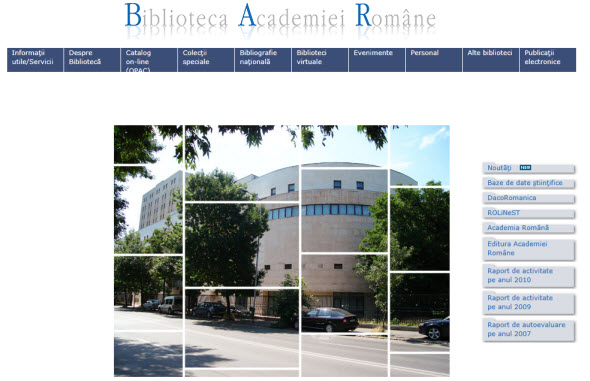 Similar to the National Library, the Romanian Academy Library (BAR) is currently in the process of making its holding available digitally. The BAR started registering its holdings on-line in 1998. It currently has digitized approximately 100,000 records: 90% of them are books and serials received by the Library from 1996 (RAL catalog). But the Web-site of the BAR offers also the possibility to search an on-line catalog of manuscripts and old books, which includes approx. 4,000 records (ORB catalog). The two catalogs cannot be searched at the same time, the visitor has to choose one of them. Visitors are offered also the possibility to search the Virtual Library Eminescu (IMG catalog), which will include the entire collection of manuscripts and correspondence by Eminescu held at the Romanian Academy Library. The IMG catalog is now under construction.
Similar to the National Library, the Romanian Academy Library (BAR) is currently in the process of making its holding available digitally. The BAR started registering its holdings on-line in 1998. It currently has digitized approximately 100,000 records: 90% of them are books and serials received by the Library from 1996 (RAL catalog). But the Web-site of the BAR offers also the possibility to search an on-line catalog of manuscripts and old books, which includes approx. 4,000 records (ORB catalog). The two catalogs cannot be searched at the same time, the visitor has to choose one of them. Visitors are offered also the possibility to search the Virtual Library Eminescu (IMG catalog), which will include the entire collection of manuscripts and correspondence by Eminescu held at the Romanian Academy Library. The IMG catalog is now under construction.
There are three searching options for every catalog: you can either browse authors, titles and subjects, or do a simple or combined search.
Biblioteca Centrala Universitara Carol I
The Central Library of the University of Bucharest (BCU) was founded in 1891 by decree of King Carol I, who designated a foundation to maintain the collection and reading rooms of what was to be the central university library of the Kingdom’s capital. The University Library has lead the way in digitization among leading research institutions, and is the only library that can boast to having digitized the greatest share of its collection. More importantly, the BCU OPAC has made significant progress in recent years in terms of linking materials from different collections into one search. The BCU OPAC can be directed to search its general holdings as well as specialized databases, including its digital collection of materials, its catalog specializing in European materials from outside Romania, and its specialized article database. In addition, the OPAC allows patrons to search the BCU’s numerous affiliate libraries, all digitized separately, including the History Library, the Library of Foreign Languages and Literatures, Biology, Chemistry, Journalism, Philosophy, Psychology and Political Science. Most importantly, patrons can easily search the newly operational Rolinest Catalog, which links the online records of the leading twelve Romanian scholarly libraries. Similarly to National Library, scholars need to remain conscious of numerous linguistic issues that make searching for especially older materials a sometimes complicated matter.
Rolinest (Romanian Library Network Science & Technology)
The Rolinest online catalog is the largest digital collection in Romania. It is an integrated catalog allowing patrons to search currently twelve libraries simultaneously, including the BCU Carol I in Bucharest, the BCU Mihai Eminescu Library in Iaşi,the BCU Lucian Blaga in Cluj-Napoca, the BCU Eugen Todoran in Timişoara, the RAM in Bucharest, the Polytechnic University Library in Bucharest, the Polytechnic University Library in Timişoara, the Technical University “Gh. Asachi” in Iaşi, the Technical University in Cluj-Napoca, the University Library “Lucian Blaga” in Sibiu, the Library of the National Nuclear Physics Institute “Horia Hulubei” and the Mureş country library.

The Rolinest project was begun in 2004 as NUSIDOC ( Unitary National System of Scientific and Technical Information and Documentation) designed to integrate the online catalogs of four central university libraries (BCU) in Iaşi, Bucharest, Cluj-Napoca, and Timişoara and the Bucharest Polytechnic University. In the years since launching the first OPAC in December 2005, Rolinest has expanded to include seven more libraries, as well as online databases such as ROMDOC, which specializes in so-called “gray literature” from the communist era. Under this system , local libraries update and maintain their own catalogs and the information is retrieved by the user in shared virtual catalog RoLiNeST. Patrons can use Rolinest to search foreign libraries as well, in fact this is the default setting (ANELIS), so if searching of Romanian library collections is desired that setting should be chosen manually. It is also possible to instruct the search to perform within more narrow parameters, including searching just the university libraries and finally just the Academy Library, as desired.
Periodical Resources
Publicatiunile periodice romanesti (ziare, gazete, reviste) vol. 1 (1820-1906)
Ioan Bianu, Nerva Hodos. Bucharest: Academia Romana, 1913.
U of I Library Call number: International & Area Studies Romanian/Moldovan Reference (Slavic) 016.0559 H66P
This work is a bibliographical description of Romanian newspapers and journals. The criteria fixed in 1895 by the Romanian Academy in order to establish which periodicals were to be included in this bibliography are the following: 1) linguistic criterion (Romanian language); 2) geographical criterion (periodicals in other languages but published in Romania); 3) ethnical criterion (periodicals published abroad but written by Romanian authors).
The bibliography is mainly based on the collection of the Library of the Romanian Academy and on previous bibliographical works of the same kind, like the bibliography by Aleksandru Pop Bibliografia publicatiunilor periodice romaneti si a celor publicate in limbi straine in Romania sau de romani in strainatate, 1889.
The periodicals are listed in alphabetical order. There is no index.
Each entry includes information on title, subtitle, place of publication, publication history, frequency, format, editor(s), collaborators, and publisher. Some times additional annotations are included.
The introduction, written by the distinguished Romanian bibliographer Ioan Bianu, is an accurate description of the history of the Romanian press.

Publicatiile periodice romanesti (ziare, gazete, reviste) , vol. 2: catalog alfabetic 1907-1918 + supplement 1790-1906.
Baiculescu, George; Raduica, Georgeta; Onofrei, Neonila. Bucuresti: Editura Academiei Respublicii Socialiste Romania, 1969.
U of I Library Call number: International & Area Studies Romanian/Moldovan Reference (Slavic) 016.0559 H66P
Publicatiile periodice romanesti (ziare, gazete, reviste) , vol. 3: 1919-1924.
Stance Desa, Ileana; Morarescu, Dulciu; Patriche, Ioana; Raliade, Adraina. Bucharest: Editura Academiei Respublicii Socialiste Romania, 1987.
U of I Library Call number: International & Area Studies Romanian/Moldovan Reference (Slavic) 016.0559 H66P
These two volumes present themselves as a continuation of the precedent bibliography. Volume 2 includes a supplement with a list of new titles not included in the first volume, and with additions and corrections to the entries of the first volume. Volume 3 has a list of sources consulted for reference.
Dictionarul Presei Romanesti (1731-1918)
Raduica, Georgeta; Raduica, Nicolin. Bucharest: Editura Stiintifica, 1995.
U of I Library Call number: International & Area Studies Romanian/Moldovan Reference (Slavic) 055.9103 R119d
This dictionary includes bibliographical descriptions of 7500 periodicals, including almanacs and calendars. One interesting feature is that it includes approx. 50 titles, which were introduces with double numeration after 1989. It is easely accessible through a name index, a geographical index, and a chronological index.

The period between 1924 and 1990 is not well covered. The only useful work for the years before the half of the century is a bibliography published by the Romanian National Library under the title Publicatii periodice rominesti (Bucuresti: s.n., 1957), but unfortunately not held by any US institutions. For the second half of the XX century possible sources are the periodical publication Newspapers and periodicals from Rumania (scattered issues held by some US institutions) and the monograph Catalogul publicatiilor romanesti: periodice si seriale (held by LC).
The lack of general periodical bibliographies can be partially overcome using a bibliography for literary periodicals:
Dictionarul presei literare romanesti, 1790-1990.
Ion Hangiu. Bucharest: Editura Fundatiei Culturale Romane, 1996.
U of I Library Call number: International & Area Studies Romanian/Moldovan Reference (Slavic) 055.9103 H193d1996
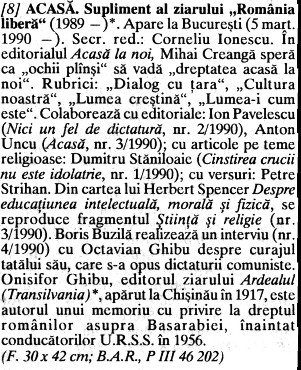
This dictionary includes 2206 periodical and non-periodical publications in Romanian or in other languages, but focusing on Romanian studies. Each entry includes title and subtitle of the publication, a brief characterization, publication history and place of publication, frequency, editors, most important sections within the publication, main collaborators, format, and a critical bibliography. A name index, a geographical, and a chronological index make this bibliography very easy to use.
Articole din publicatii periodice. Cultura.
Bucuresti: Biblioteca Nationala a României 2000-. Not at U of I Library.
OCLC: 46630652 (Available at University of Chicago, Stanford University, and Library of Congress)
Since 2000, the Romanian National Library (BNR) has published this monthly bibliography of articles published in Romanian periodicals dealing with subjects in the most broadly-defined humanities. While U of I does not receive this publication, patrons can access it online beginning with 2008 through the BNR archive cite at http://www.bibnat.ro/Arhiva-s237-ro.htm .

This is the most thorough bibliographic compilation of Romanian article publications specialized in the humanities. In addition to a detailed subject table of contents, each issue contains three intricate indexes at the back, including a name, source, and subject index.
Bibliografia Nationala Romana, Publicatii seriale , 1992-to date
Bucharest: Biblioteca Națională a României, 1992-.
U of I Library Call Number: International & Area Studies Romanian/Moldovan Reference (Slavic) for recent issues 016.0559 B85b1; Main Stacks for 1992-2002 [lacks v.8 and v.9].
This bibliographical series compiled by the Romanian National Library started in 1992. It is yearly published and includes the entire national periodical production. The first 3 volumes cover the period from 1990-1993. The following volumes cover the production of the previous year. U of I has 1992-1998 and 2000-2007. Beginning with the 2008 issue, the entire publication is available online at the BNR website, archive page, at http://www.bibnat.ro/Arhiva-s237-ro.htm .
The citations are organized according to the subject. The first section is called “Generalitati” and includes such topics like civilization, culture, press, etc. The following sections are devoted to Philosophy, Religion, Social Sciences, Natural Sciences, Applied Sciences, Art and Sport, Linguistics and Literature, Geography and History.
A detailed table of contents allows searching for specific topics. Other access points are a journal title list and a corporate author list. Starting from the IV volume (1994), there are also an institution index, and a personal name index.
PERIODICAL INDEXES
Bibliografia analitica a periodicelor romanesti
Lupu, Ioan; Camariano, Nestor; Papadima, Ovidiu. Bucuresti: Editura Academiei Respublicii Socialiste Romania, Vol. 1: 1790-1850 (published in 1966-1967); Vol. 2: 1851-1858 (published in 1970-1972).
U of I Library Call number: International & Area Studies Romanian/Moldovan Reference (Slavic) Q. 016.0559 AC1B
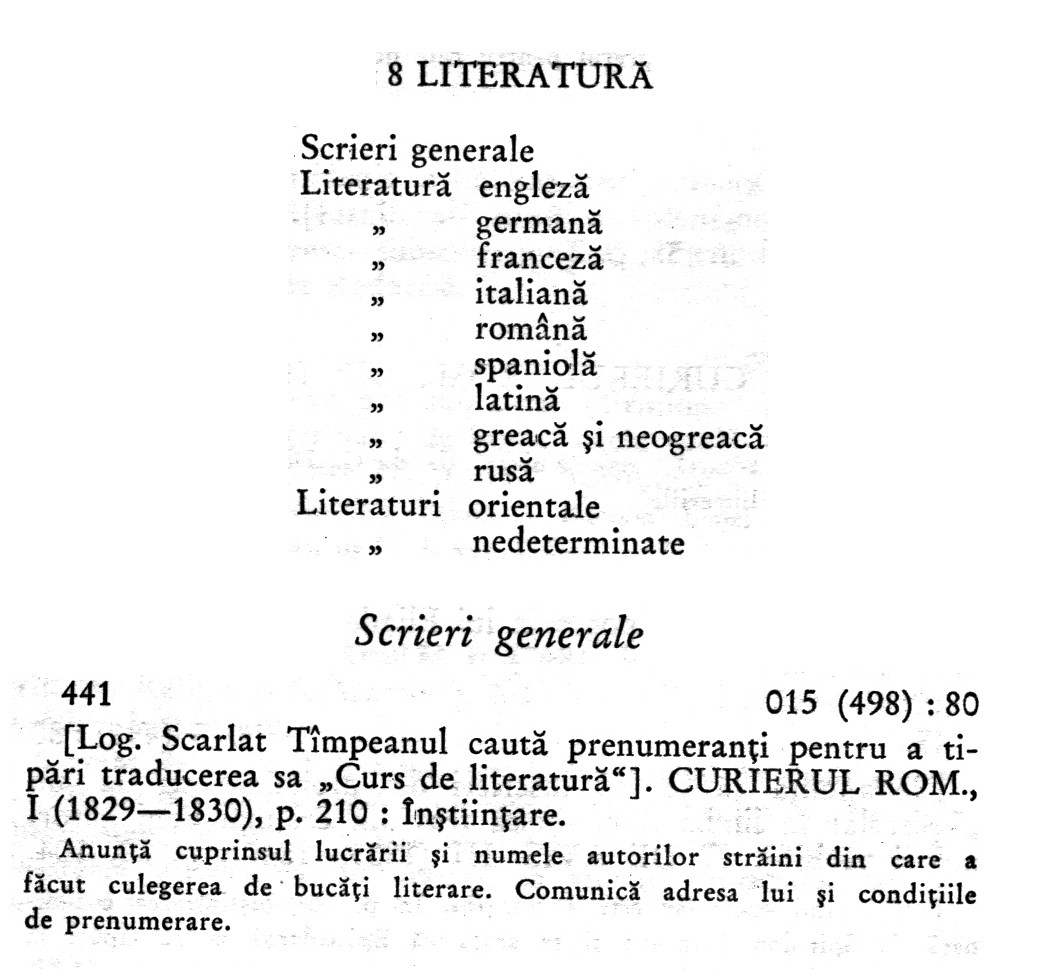 This bibliography includes bibliographical descriptions of every kind of article, essay, and literary work published in journals and newspapers in Romanian language, or in other languages but published within the Romanian territory (including Moldavia), or published abroad but written by Romanian authors.
This bibliography includes bibliographical descriptions of every kind of article, essay, and literary work published in journals and newspapers in Romanian language, or in other languages but published within the Romanian territory (including Moldavia), or published abroad but written by Romanian authors.
The period covered starts from 1790, date of publication of the first Romanian periodical Courier de Moldavie . (Other sources consider Calendar as the first Romanian periodical: it started in 1731 in Transilvania). For the period between 1829 and 1850 the bibliography indexes 75 periodicals. For a list of the periodicals taken into consideration see pages XV-XIX vol. 1, and pages V-X vol.2.
The first part of the bibliography is called “Generalitati” and includes the following topics: Culture, Civilization, Progress; Bibliographies and Catalogs; Libraries; Periodicals; Scientific Societies, Academies, and Museums; Collections and Series; Manuscripts and Rare Books. The following parts are devoted to Religion; Social Sciences; Philology and Linguistics; Natural Sciences and Mathematics; Technical Sciences, Medicine Agriculture; Arts; Literature; History, Geography and Biographies. A very detailed table of contents is to be found at the end of the volumes. Other useful access points are 3 alphabetical indexes, respectively for authors and translators, for pseudonyms, and for personal names. The entries are annotated.
The period between 1859 and 1952 is not covered. This gap could be only partially covered using Cresterea colectiunilor for the period 1906-1919, and the Osteuropäische Bibliographie for the period 1920-1923.
Buletinul bibliografic. Seria B. Articole si recenzii din presa . Volumes 1-4, 1953-1956.
Not at U of I Library.
OCLC: 10413140 (See holdings of New York Public Library and University of Wisconsin, Madison.)
Bibliografia periodicelor din Republica Populara Romina , Volumes 5-10, 1957-1962.
Not at U of I Library.
OCLC: 8576450 (See University of Wisconsin, Madison for complete holdings.)
Bibliografia Republicii Socialiste Romania. Articole din publicatii periodice si seriale , Volumes 11-38, 1963-1989.
Bucharest: Biblioteca Centrală de Stat a Republicii Socialiste România, 1965-.
U of I Library Call number: Main Stacks 016.0559 B85B (some issues missing)
This index was published bimonthly by the Central State Library of the Romanian Socialist Republic as Series B, a second bulletin (following the one on books, albums and maps) that began appearing from January 1, 1953 and contained lists of journal and newspaper articles (U of I has March- December 1956 Series A, but series B begins in 1963). In October 1956 the Book Chamber was incorporated in the National Library of the Romanian Socialist Republic. Consequently, starting from 1957, the two bulletins changed their title in Bibliografia Republicii Populare Romane (1957-1966) and Bibliografia Republicii Socialiste Romania (1967-1990), Series A and Series B. At the same time the Central State Library (founded in 1955) started publishing other bibliographical series for other categories, like musical materials and discs. A list of the periodicals indexed appears at the beginning of every issue. The work is easily accessible through a detailed table of contents and an alphabetical index of authors and personal names mentioned in the titles.
Romanian Scientific abstracts, Social Sciences.
Academy of the Romanian People’s Republic Scientific Documentation Centre. Bucharest: Biblioteca Centrală de Stat a Republicii Socialiste România, 1964-1988.
U of I Library Call Number : Oak Street Facility 305 RUM. The Library has 1964-1970 and 1987-1988.
In 1964 the Scientific Documentation Centre of the Academy of the Romanian People’s Republic started the publication of a monthly bulletin in two series: Natural Sciences and Social Sciences. These bulletins were published in English and Russian, and aimed to “provide scientists abroad with the most complete and rapid information about the achievements of Rumanian research in the main branches of the fundamental sciences” (vol. 1, page 3). Although this bibliography is not a National Bibliography, it can be considered a good alternative for it for scholars not familiar with the Romanian Language.
The materials are recorded according to the field of study: Economic Sciences; Jurisprudence; Philosophy, Psychology, Logic; History, Ethnography; Linguistics, Philology; Theory and History of Literature and Arts. A table of contents at the beginning of each volume gives more detailed subjects within every branch. A list of the publications recorded can be found at the end of each bulletin.
The citations give full bibliographical reference and abstracts. There is no index.
Literatura bibliologica romaneasca, Articole din publicatii periodice, 1990-1998
Ilis, Florina; Kiraly, Istvan; Marcu, Angela.
No institution holds this CD in the U.S.
Cultura in Romania: referinte bibliografice si documentare din periodice romanesti (1992-1999).
OCLC: 37046394 (See holdings at Yale and New York Public Library.)
Bibliography of bibliographies
Romania. A bibliographic Guide
Stephen A. Fischer-Galati, Slavic and central European Division, Reference Department, Library of Congress, Washington, 1963.
U of I Library Call number: International & Area Studies Romanian/Moldovan Reference 016.9498 F525r
Although this work is not a bibliography of bibliographies in the strict sense of the word, it is still valuable to the purpose of “selecting materials relevant to the study of Romania” (page VII). The first part of it is a bibliographical survey. It opens with a concise description of bibliographies and general reference works. Distinct chapters are devoted to the land, the people, history, politics and government, law and justice, social conditions, economics, religion, intellectual life, language and literature. Each of them includes a bibliography of specialized topical bibliographies.
Apart from the table of contents, a detailed bibliographical listing makes this work easily accessible. Since the publications listed in this bibliography are accompained by a location symbol, this work is also a useful tool to locate monographs on Romania held in US libraries.
Monograph bibliographies and Handbooks
Bibliografia istorica a Romaniei
Bucharest: Editura Academiei Republicii Socialiste România; 1970.
U of I Library Call number: International & Area Studies Romanian Reference (Slavic) 015.498 B471
This is a collection of historical bibliographies in 10 volumes.
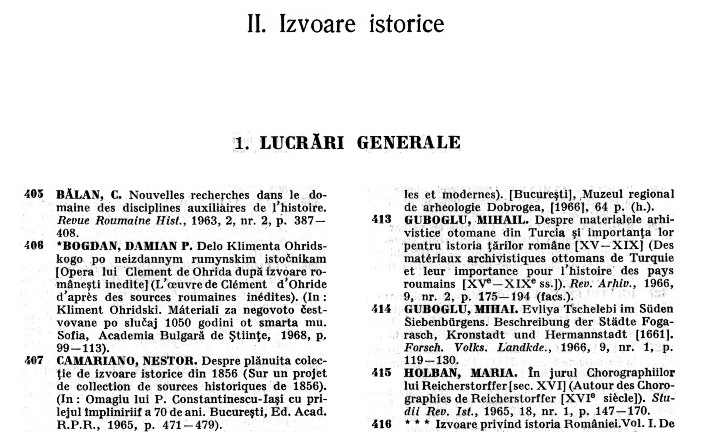
The first volume (Bibliografia istorica a Romaniei 1944-1969, Bucuresti: Editura Academiei Respublicii Socialiste Romania) was published in 1970 under the auspices of the Institute of History and Archaeology of Cluj. It includes approx. 8000 entries for Romanian works written between 1944 and 1969, and devoted to every kind of topic and time period in the history of Romania, and also of other nations. It is a sort of compendium on the development of historiography in Romania in those 25 years.
The second and the third volumes (Bibliografia istorica a Romaniei. Secolul XIX, Bucuresti: Editura Academiei Respublicii Socialiste Romania) show a different approach: it is part of a project of the Institute of History “N.Iorga” in Bucharest for a general bibliography of works appeared in the XIX century and in the first half of the XX century, and devoted to the history of the Romanian country and the Romanian people in the XIX century. The project was meant to include 5 major parts: general works on the country and the people; economical life; political life; cultural life; biographies. Actually only the parts related to general description of Romania, economics, and biographies have been published.
Volume II part 1 Cadrul general. Tara si locuitorii (published in 1972) includes geographical and statistical studies, maps, travellers’ descriptions, works on local history and on minorities living on the Romanian territory, accounts on the Romanian people living abroad and on their relations with other nationalities. The basis for this bibliography were 30 libraries on the whole Romanian territory.
The material included in the volume II part 2 Viata economica (published in 1999) was first prepared in 1970 by G.Zane, and then revised and corrected in 1992 by the National Institute of Economical Research. It covers the most important fields of Romanian economical life: agriculture, industry, commerce, transportation and means of communication, finances.
Volume III part 5 Biografii (published in 1974) includes materials of biographical nature appeared before 1960:, such as biographies, autobiographies, memoirs, correspondence, and genealogical documents.
Volume IV (Bibliografia istorica a Romaniei 1969-1974, Bucuresti: Editura Academiei Respublicii Socialiste Romania) takes over the project started with volume I, that is to show the course of Romanian historiography. It is a selective bibliography including 10,000 works on Romanian history published between 1969 and 1974. Its value is in the fact that it cites both monographs and articles from periodicals. A peculiarity of this work is that it provides every Romanian title with a translation in French.
The following volumes have the same structure, each of them covers a period of 5 years and is accessible through an author index. This multivolume work is the most complete bibliography on Romanian history.
Rumä nien
Klaus-Detlev Grothusen. Göttingen: Vandenhoeck & Ruprecht, 1977, pages 654-691.
U of I Library Call number : Oak Street Facility 914.98 R8632
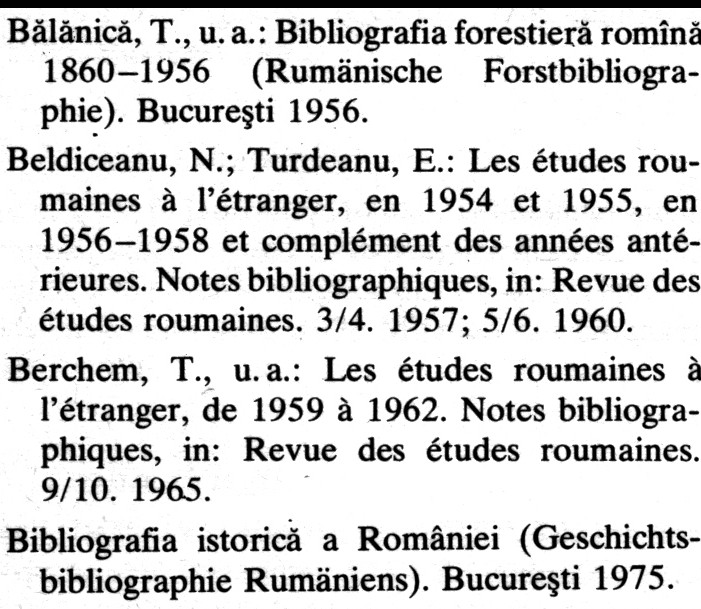
This work is the second volume of the guides to South-Eastern Europe compiled by the Südosteuropa-Arbeiterkreis der Deutschen Forchungsgemeinschaft. The last 40 pages of this work provide bibliographical references to the various sections taken into consideration: state and politics, economy, society, culture and science. Every section is subdivided into more specific topics. There is also a brief section on general descriptions and reference works on Romania.
Romania
Andrea and Dennis Deletant. Oxford: Clio Press Ltd, 1985.
U of I Library Call number: International & Area Studies Romanian/Moldovan Reference (Slavic) 016.9498 D378r
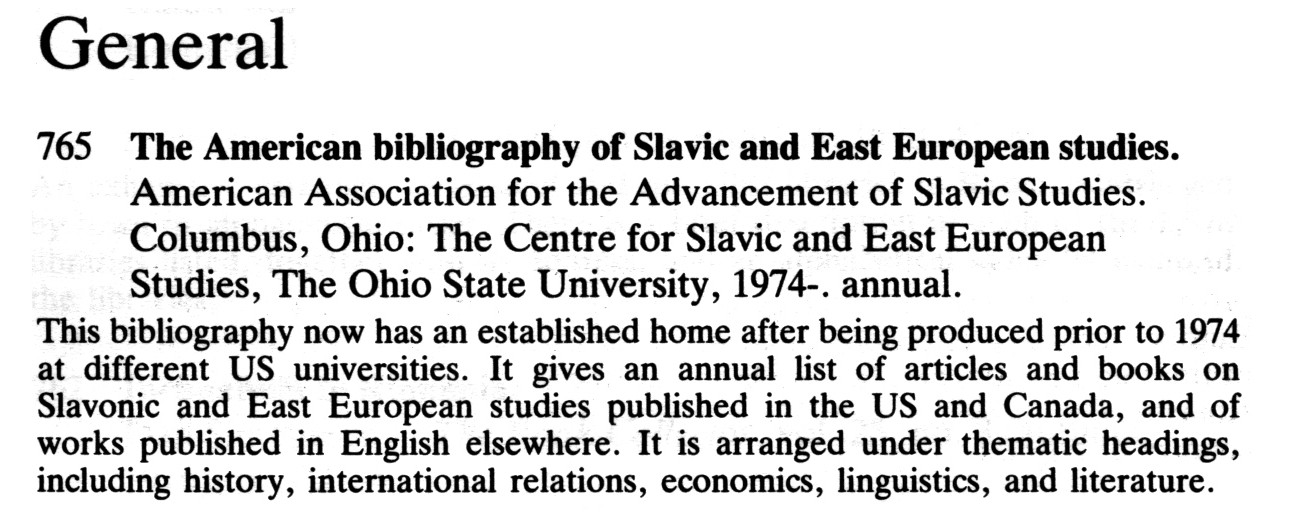
This bibliography lists mostly works in English. It takes into consideration all aspect of social, political, economical and cultural life in Romania. It also includes a small section about general and specialized bibliographies on Romania. It is easily accessible through a detailed table of contents and an index of authors, titles and subjects. The chronological coverage goes from the ’30s to the ’80s, however the majority of the works cited was written between 1960 and 1980.
Ceausescu’s Romania. An Annotated Bibliography
Opritsa D. Popa, Marguerite E.Horn. Westport: Greenwood Press, 1994.
U of I Library Call number: International & Area Studies Romanian/Moldovan Reference 016.9498 C32
This annotated bibliography includes approx. 1,000 publications written by Western scholars on Romania. It covers the period from 1965 to 1989, that is Ceausescu’s dictatorship. It lists “books, journal articles, reports, occasional papers, chapters in books, U.S. doctoral dissertations, and government documents” (page IX). The bibliography is organized by subject. Apart from the table of contents, it has two access points: an author and a subject index.
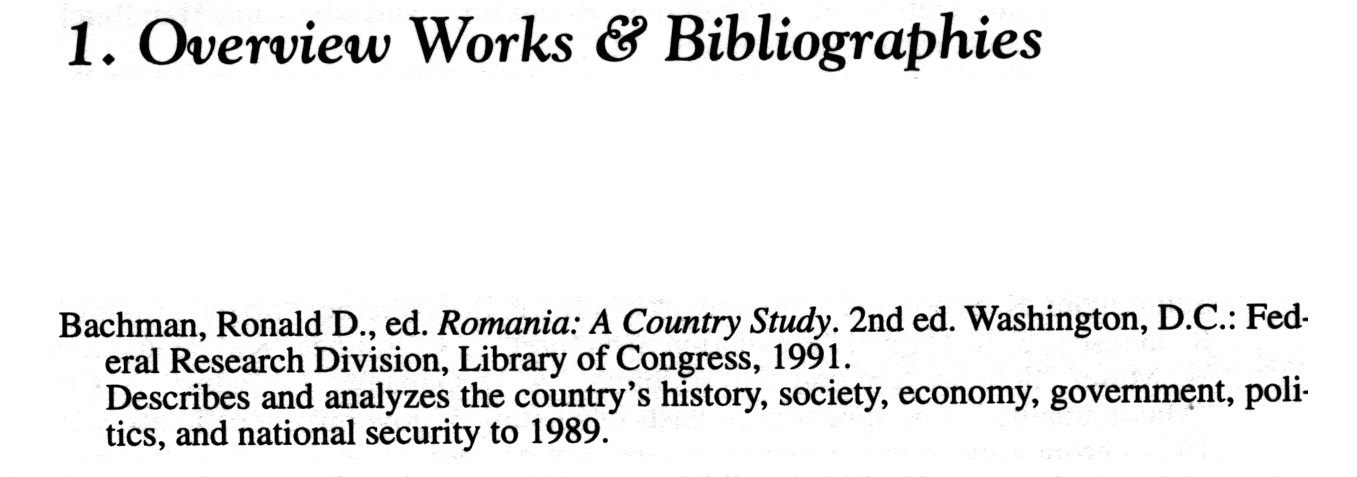
Rumyniia. Rekomendatel’nyi bibliograficheskii spravochnik
S.M.Stetskevich, S.B.Frolov. Moskva: Kniga, 1986.
U of I Library Call number: Oak Street Facility 016.9498 R869
This guide is an annotated bibliography to Romania. It lists general publications on history and geography, but also more specific works on the economical, social, cultural and political life of the country. It includes mostly monographs, however sometimes are listed also articles from encyclopedias. Its chronological coverage is very limited: 1960-1980.
Romanian Military Bibliography
Bucharest, Military Publishing House, 1985. Not at UIUC; Available through ILL
OCLC: 16082282 (See holdings at Library of Congress, University of Chicago, and University of California, Berkeley)
This volume, published in English for Western consumption during the late reign of Nicolae Ceausescu, seeks to educate ignorant Westerners about the importance of the Romanian leaders’ contribution to the evolution of military thought. The entire first chapter lists works he allegedly authored. Nevertheless, this is a useful volume for those researching military history that do not know Romanian, since all the titles presented are offered in translation also. The annotations are also in English, making the volume additionally useful, particularly because its content exceeds just military matters and includes several works of history. It also contains a separate chapter devoted to reference works, including bibliographies, encyclopedias, and monographs, that are not necessarily about military matters. While many of the titles, published in the 1970s, seek to construct a heroic usable past for Romanians, they still contain much information necessary to researchers. Chapters three and four (most of the book) are devoted to military issues.

